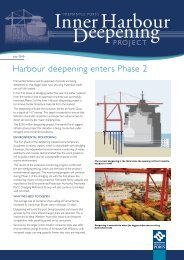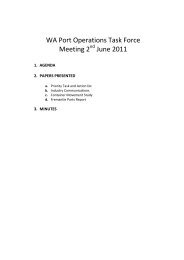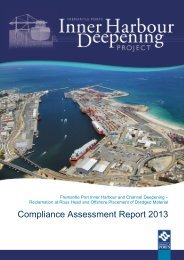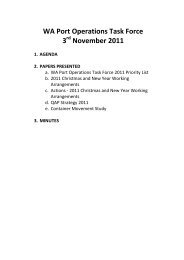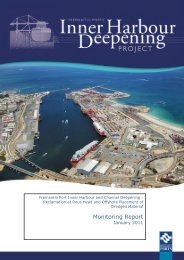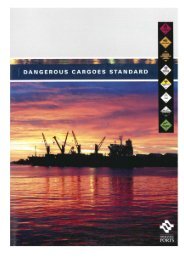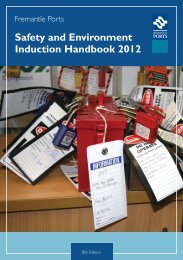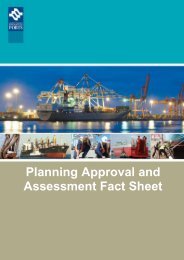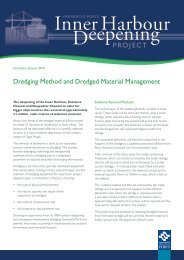Fremantle Port Inner Harbour and Channel ... - Fremantle Ports
Fremantle Port Inner Harbour and Channel ... - Fremantle Ports
Fremantle Port Inner Harbour and Channel ... - Fremantle Ports
- No tags were found...
You also want an ePaper? Increase the reach of your titles
YUMPU automatically turns print PDFs into web optimized ePapers that Google loves.
Table 2 Tide predictions for the <strong>Port</strong> of <strong>Fremantle</strong>Tuesday 11th Oct 2011Wednesday 12th Oct2011(www.transport.wa.gov.au)2.4. Video analysis0.55m @ 3:43 AM0.72m @ 10:15 AM0.61m @ 2:07 PM0.89m @ 8:53 PM0.52m @ 4:14 AM0.70m @ 10:58 AM0.61m @ 2:23 PM0.93m @ 9:10 PMThe Geo Oceans customised Visual Basic software program ‘GO Video’ was used forvideo analysis that allowed the analyst to assign habitat attributes to the GPSlocation (position) where the video was recorded. A marine scientist trained in videoanalysis <strong>and</strong> habitat classification analysed the video footage in real-time (as thevideo is recorded). Position data were received at approximately 1-second intervals,<strong>and</strong> recorded in a database table, along with the biota <strong>and</strong> substrate attributesassigned using the GO Video software. These attributes include visually-assessedpercentage cover estimates of the biota <strong>and</strong> substrate classes provided in Appendix1 <strong>and</strong> Appendix 2. Table 3 lists the attributes that were captured <strong>and</strong> geo-referencedusing the video analysis software. Figure 1 shows the biota <strong>and</strong> substrateclassification hierarchy used to group the attributes.The level of taxonomic detail recorded varied according to the video quality, whichin turn was dependent on the environmental conditions (e.g. water visibility <strong>and</strong> seastate) <strong>and</strong> the speed at which the towed video was filmed. In all cases the videoquality was adequate to make distinctions of the biota into the level 2 groups inFigure 1.The video analysis data was checked in Microsoft Access for blank fields <strong>and</strong>erroneous GPS positioning <strong>and</strong> habitat classifications. Errors were removed thenthe data were converted into a GIS shapefile (point data) <strong>and</strong> displayed in Arc GISsoftware for further error checking. The video analysis data were symbolisedshowing presence <strong>and</strong> absence of the major habitat categories (i.e. macroalgae,hard coral, filter feeders, soft coral <strong>and</strong> seagrass) at each survey site. The point datawere reviewed for any habitat classifications that were not consistent with thesurrounding point data. If the point data were considered to be erroneous the videofootage was reanalysed using the same methods as the real-time analysis method.6 of 13



